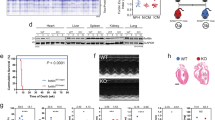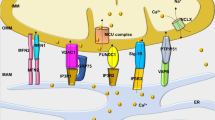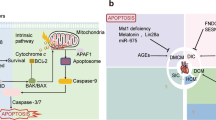Abstract
Apoptosis or programmed cell death is an evolutionarily conserved process of cell death, wherein cells die without provoking significant inflammatory response. There is convincing evidence that apoptosis contributes to the progression of heart failure. Apoptosis occurs through a cascade of subcellular events including cytochrome c release into the cytoplasm and activation of proteolytic caspases. Activated caspases lead to fragmentation of cytoplasmic proteins, including contractile apparatus, to a variable extent. It is proposed that the release of cytochrome c from mitochondria and contractile protein loss in living heart muscle cells contributes to systolic dysfunction. Interestingly, despite extensive changes in the cytoplasm, nuclear damage, which is the final event in apoptosis, is rather infrequent in the failing heart. Since the nucleus remains unaffected and the genetic blueprint intact in cells with interrupted apoptosis, these heart muscle cells might be amenable to cytoplasmic reconstitution. This process of 'apoptosis interruptus' could allow development of novel strategies to reverse or attenuate heart failure.
Key Points
-
Heart failure is a major cardiovascular health problem worldwide
-
Heart failure is characterized by inexorable progression of systolic dysfunction through the process of adverse cardiac remodeling even after the initial, causal injury has abated
-
Understanding the pathophysiological substrates of cardiac remodeling can help in the development of novel strategies for prevention, arrest and reversal of the remodeling process
-
Apoptosis plays a pivotal role in heart failure. Although the apoptotic cascade is initiated, it does not complete in heart failure ('apoptosis interruptus')
-
Interrupted apoptosis reconfirms that heart failure could often be a reversible disease state, and offers an attractive target for management
This is a preview of subscription content, access via your institution
Access options
Subscribe to this journal
Receive 12 print issues and online access
$209.00 per year
only $17.42 per issue
Buy this article
- Purchase on Springer Link
- Instant access to full article PDF
Prices may be subject to local taxes which are calculated during checkout







Similar content being viewed by others
References
Thom T et al. (2006) Heart disease and stroke statistics—Update 2006: a report from the American Heart Association Statistics Committee and Stroke statistics subcommittee. Circulation 113: e85–e151
Narula J and Young JB (2005) Pathogenesis of heart failure: the penultimate survival instinct. Heart Failure Clinics 1: xi–xii
Massie BM and Conway M (1987) Survival of patients with congestive heart failure: past, present, and future prospects. Circulation 7: IV11–IV19
Gerdes AM and Capasso JM (1995) Structural remodeling and mechanical dysfunction of cardiac myocytes in heart failure. J Mol Cell Cardiol 27: 849–856
Francis GS and McDonald KM (1992) Left ventricular hypertrophy: an initial response to myocardial injury. Am J Cardiol 69: 3G–7G
Beltrami CA et al. (1995) The cellular basis of dilated cardiomyopathy in humans. J Mol Cell Cardiol 27: 291–305
Pouleur HG et al. (1993) Changes in ventricular volume, wall thickness and wall stress during progression of left ventricular dysfunction. The SOLVD Investigators. J Am Coll Cardiol 22 (Suppl A): S43A–S48A
Chandrashekhar Y and Narula J (2003) Death hath a thousand doors to let out life. Circ Res 92: 710–714
Narula J et al. (1996) Apoptosis in myocytes in end-stage heart failure. N Engl J Med 335: 1182–1189
Narula J et al. (1999) Apoptosis in heart failure: release of cytochrome c from mitochondria and activation of caspase-3 in human cardiomyopathy. Proc Natl Acad Sci USA 96: 8144–8149
Wencker D et al. (2003) A mechanistic role for cardiac myocyte apoptosis in heart failure. J Clin Invest 111: 1497–1504
Hayakawa K et al. (2003) Inhibition of granulation tissue cell apoptosis during the subacute stage of myocardial infarction improves cardiac remodeling and dysfunction at the chronic stage. Circulation 108: 104–109
Chandrashekhar Y et al. (2004) Long-term caspase inhibition ameliorates apoptosis, reduces myocardial troponin-I cleavage, protects left ventricular function, and attenuates remodeling in rats with myocardial infarction. J Am Coll Cardiol 43: 295–301
Katz AM (1994) The cardiomyopathy of overload: an unnatural growth response in the hypertrophied heart. Ann Intern Med 121: 363–371
Francis GS and Carlyle WC (1993) Hypothetical pathways of cardiac myocyte hypertrophy: response to myocardial injury. Eur Heart J 14 (Suppl J): S49–S56
Ertl G et al. (1993) Ventricular remodeling after myocardial infarction: experimental and clinical studies. Basic Res Cardiol 88 (Suppl 1): S125–S137
Agah R et al. (1997) Adenoviral delivery of E2F-1 directs cell cycle reentry and p53-independent apoptosis in postmitotic adult myocardium in vivo. J Clin Invest 100: 2722–2728
Li Z et al. (1997) Increased cardiomyocyte apoptosis during the transition to heart failure in the spontaneously hypertensive rat. Am J Physiol 272: H2313–H2319
Teiger E et al. (1997) Apoptosis in pressure overload induced heart hypertrophy in the rat. J Clin Invest 97: 2891–2897
Cheng W et al. (1996) Programmed myocyte cell death affects the viable myocardium after infarction in rats. Exp Cell Res 226: 316–327
Garg S et al. (2005) Apoptosis and heart failure: clinical relevance and therapeutic target. J Mol Cell Cardiol 38: 73–79
Olivetti G et al. (1997) Apoptosis in the failing human heart. N Eng J Med 336: 1131–1141
Reed JC and Paternostro G (1999) Postmitochondrial regulation of apoptosis during heart failure. Proc Natl Acad Sci USA 96: 7614–7616
Narula J et al. (2001) Apoptosis and the systolic dysfunction in congestive heart failure: story of apoptosis interruptus and Zombie myocytes. Cardiol Clin 19: 113–126
Haider N et al. (2002) Apoptosis in heart failure represents programmed cell survival, not death, of cardiomyocytes and likelihood of reverse remodeling. J Card Fail 8 (Suppl): S512–S517
Kanoh M et al. (1999) Significance of myocytes with DNA in situ nick-end labeling (TUNEL) in hearts with dilated cardiomyopathy: not apoptosis but DNA repair. Circulation 99: 2757–2764
Morissette MR and Rosenzweig A (2005) Targeting survival signaling in heart failure. Curr Opin Pharmacol 5: 165–170
Narula N et al. (2005) Is the myofibrillarlytic myocyte a forme fruste apoptotic myocyte? Ann Thorac Surg 79: 1333–1337
Communal C et al. (2002) Functional consequences of caspase activation in cardiac myocytes. Proc Natl Acad Sci USA 99: 6252–6256
Leist M et al. (1997) Intracellular adenosine triphosphate (ATP) concentration: a switch in the decision between apoptosis and necrosis. J Exp Med 185: 1481–1486
Grazette LP et al. (2004) Inhibition of ErbB2 causes mitochondrial dysfunction in cardio-myocytes. Implications for herceptin-induced cardiomyopathy. J Am Coll Cardiol 44: 2231–2238
Crone SA et al. (2002) ErbB2 is essential in the prevention of dilated cardiomyopathy. Nat Med 8: 459–465
Matsui T et al. (2001) Akt activation preserves cardiac function and prevents injury after transient cardiac ischemia in vivo. Circulation 104: 330–335
Bartling B et al. (1999) Myocardial gene expression of regulators of myocyte apoptosis and myocyte calcium homeostasis during hemodynamic unloading by ventricular assist devices in patients with end-stage heart failure. Circulation 100: 216–223
Milting H et al. (1999) Altered levels of NRNA of apoptosis-mediating genes after mid-term mechanical ventricular support in dilated cardiomyopathy—first results of the Halle Assist Induced Recovery Study (HAIR). Thorac Cardiovasc Surg 47: 48–50
Arbustini E et al. (2001) Apoptosis in heart failure: abrogation of cytochrome c release after ventricular unloading by LVAD [abstract]. Med Pathol 14: 43A
Adams JW et al. (1998) Enhanced Gαq signaling: a common pathway mediates cardiac hypertrophy and apoptotic heart failure. Proc Natl Acad Sci USA 95: 10140–10145
Boersma HH et al. (2005) Past, present, and future of annexin A5: from protein discovery to clinical applications. J Nucl Med 46: 2035–2050
Yamamoto S et al. (2003) Activation of Mst1 causes dilated cardiomyopathy by stimulating apoptosis without compensatory ventricular myocyte hypertrophy. J Clin Invest 111: 1463–1474
Hirota H et al. (1999) Loss of a gp130 cardiac muscle cell survival pathway is a critical event in the onset of heart failure during biomechanical stress. Cell 97: 189–198
Yarbrough WM et al. (2003) Pharmacologic inhibition of intracellular caspases after myocardial infarction attenuates left ventricular remodeling: a potentially novel pathway. J Thorac Cardiovasc Surg 126: 1892–1899
Goussev A et al. (1998) Effects of ACE inhibition on cardiomyocyte apoptosis in dogs with heart failure. Am J Physiol 275: H626–H631
Sabbah HN et al. (2000) Chronic therapy with metoprolol attenuates cardiomyocyte apoptosis in dogs with heart failure. J Am Coll Cardiol 36: 1698–170555
Author information
Authors and Affiliations
Corresponding author
Ethics declarations
Competing interests
The authors declare no competing financial interests.
Rights and permissions
About this article
Cite this article
Narula, J., Haider, N., Arbustini, E. et al. Mechanisms of Disease: apoptosis in heart failure—seeing hope in death. Nat Rev Cardiol 3, 681–688 (2006). https://doi.org/10.1038/ncpcardio0710
Received:
Accepted:
Issue Date:
DOI: https://doi.org/10.1038/ncpcardio0710
This article is cited by
-
Transcriptomic study of anastasis for reversal of ethanol-induced apoptosis in mouse primary liver cells
Scientific Data (2022)
-
Fortilin inhibits p53, halts cardiomyocyte apoptosis, and protects the heart against heart failure
Cell Death Discovery (2021)
-
The Regulation of Uterine Function During Parturition: an Update and Recent Advances
Reproductive Sciences (2020)
-
Heart regeneration and repair after myocardial infarction: translational opportunities for novel therapeutics
Nature Reviews Drug Discovery (2017)
-
Protein tyrosine phosphatase 1B (PTP1B) is required for cardiac lineage differentiation of mouse embryonic stem cells
Molecular and Cellular Biochemistry (2017)



